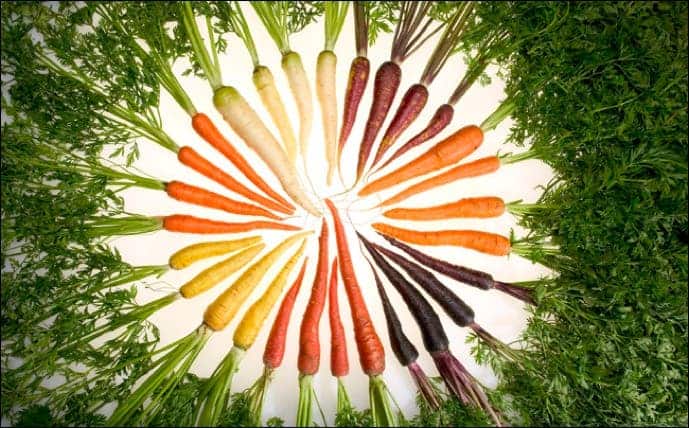Carrots are the richest source of vitamin A in the American diet, which is why you hear “they’re good for your eyes”. But did you know carrots were initially yellow and purple? Even further back, before humans domesticated carrots, the wild variety was white. Scientists know this by sequencing the DNA of the carrot, and a recent study deciphered its full genetic code. We now know what genes trigger the production of carrots’ most important nutrients, but also what teaking is required to improve the crops.

This is one of those amazing studies where genetics offers amazing insights into the history of a crop which would’ve been otherwise unavailable. Carrots were first domesticated 1,100 years ago, and over the next 3,000 years the root has gone through many breeding cycles and selections by farmers. For instance, up until the 17th century, most carrots were purple. Then, Dutch farmers started to experiment with mutant strains of purple carrots as well as yellow and white ones. This is how they eventually bred the orange variety which caught on fast because these were deemed exotic and fashionable.
“This was an important public-private project, and the genomic information has already been made available to assist in improving carrot traits such as enhanced levels of beta-carotene, drought tolerance and disease resistance,” says co-author Allen Van Deynze, director of research at the University of California, Davis’ Seed Biotechnology Center. “Going forward, the genome will serve as the basis for molecular breeding of the carrot.”
The orange carrots are also more nutritious because the coloring is derived from pigment compounds called carotenoids. Specifically, orange carrots are colored by alpha- and beta-carotene, while red carrots get their color from lycopene, yellow from lutein and purple from anthocyanin.
Once ingested by the body, these carotenoids are converted into vitamin A, an important nutrient for eye health. Thanks to the efforts of University of Wisconsin-Madison researchers led by professor Phil Simon, we now know how these compounds form.
The team sequenced 35 different types of carrots, then compared them to their wild counterparts. The carrot has 32,000 genes arranged among nine chromosomes, which code for pest and disease resistance, colorful carotenoids and more.
Around the Cretaceous and Paleogene periods — close to when dinosaurs went extinct — carrots adapted and picked some genetic advantages that allowed them to thrive. As for the colouring, a gene called Y is mainly responsible for the difference between white, yellow and orange carrots. A variation of the Y gene leads to accumulation of carotenoids — the more, the brighter orange the carrot becomes.
For the colourful compounds to accumulate, however, an additional and previously unknown gene is required. Both of these genes are recessive (two copies of each are needed), which is actually a metabolic pathway defect related to light-sensing, according to the paper published in Nature Genetics.
Plants derive nutrients like sugars by converting CO2, water and soil nutrients in the presence of light, a process called photosynthesis. Carrots being roots aren’t typically exposed to light and shouldn’t need photosynthetic pigments like carotenoid. According to Simon, early growers selected these genes because it likely helped domesticate them.
“It’s a repurposing of genes plants usually use when growing in light,” he said.
“The accumulation of orange pigments is an accumulation that normally wouldn’t happen,” says Simon, one of just a few carrot researchers around the world. “Now, we know what the genes are and what they do.”
“They could keep their crops ‘clean’ from a patch of wild carrots growing 50 meters away by choosing only the purple or yellow ones,” says Simon, who jokes: “Or maybe it was the food fad of the 10th century, with orange in the 16th.”
Over the last 40 years, breeders have made carrots with the most intense orange yet, consequently making them more nutritious. Carrots today have around 50 percent more carotene than they did in 1970.
“Globally, we hand out vitamin A capsules, but why not have people grow their own?” Simon asks. “In one square meter you can grow a single crop of carrots per year to feed up to a half dozen adults. You can grow half now and half in six months to give you a sustainable source of vitamin A and a valuable crop in the marketplace.”



